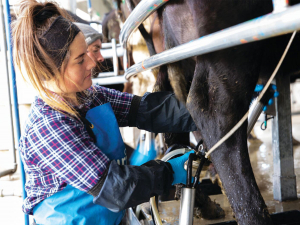2024/25 Dairy Statistics: NZ dairy farmers boost production with fewer cows
According to the New Zealand Dairy Statistics 2024/25 report, New Zealand dairy farmers are achieving more with fewer cows.
 DairyNZ have provided advice, tools and resources to support dairy farmers in keeping their teams safe during lockdown.
DairyNZ have provided advice, tools and resources to support dairy farmers in keeping their teams safe during lockdown.
DairyNZ has developed advice, tools and resources to support dairy farmers and their teams to farm safely during the Covid lockdown.
It urges farmers to keep themselves and their employees safe at milking during COVID-19 with the following tips:
"We know from medical professionals that Covid-19 stays on surfaces for at least 72 hours and is transferred via droplets. This means that we have to be extra vigilant with the hygiene of our shared work surfaces, and that we must maintain a distance of two metres from others to minimise its spread over the next four weeks of lockdown.
"Traditionally, and especially in our herringbone milking platforms, we worked closely together and with no disinfection of our surfaces. To keep everyone safe, we now need to make changes to how we milk."
What can you do to help keep your employees and yourself safe?
Tips for working together while milking
For more than 50 years, Waireka Research Station at New Plymouth has been a hub for globally important trials of fungicides, insecticides and herbicides, carried out on 16ha of orderly flat plots hedged for protection against the strong winds that sweep in from New Zealand’s west coast.
There's a special sort of energy at the East Coast Farming Expo, especially when it comes to youth.
OPINION: The latest reforms of local government should come as no surprise.
The avocado industry is facing an extremely challenging season with all parts of the supply chain, especially growers, being warned to prepare for any eventuality.
Rural recycling scheme Agrecovery is welcoming the Government's approval of regulations for a nationwide rural recycling scheme for agrichemicals and farm plastics.
Despite a late and unfavourable start, this year’s strawberry crop is expected to be bountiful for producer and consumer alike.

OPINION: Your old mate welcomes the proposed changes to local government but notes it drew responses that ranged from the reasonable…
OPINION: A press release from the oxygen thieves running the hot air symposium on climate change, known as COP30, grabbed your…